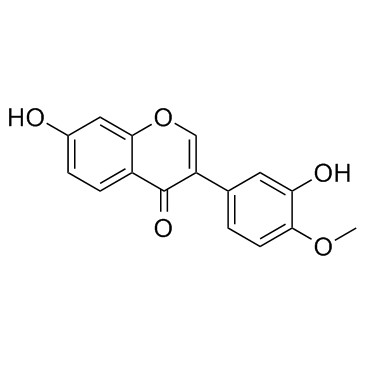Calycosin

Calycosin structure
|
Common Name | Calycosin | ||
|---|---|---|---|---|
| CAS Number | 20575-57-9 | Molecular Weight | 284.263 | |
| Density | 1.4±0.1 g/cm3 | Boiling Point | 536.8±50.0 °C at 760 mmHg | |
| Molecular Formula | C16H12O5 | Melting Point | N/A | |
| MSDS | Chinese USA | Flash Point | 205.7±23.6 °C | |
| Symbol |

GHS06 |
Signal Word | Danger | |
|
Thermal stability of kudzu root (Pueraria Radix) isoflavones as additives to beef patties.
J. Food Sci. Technol. 52(3) , 1578-85, (2015) Kudzu root, Pueraria radix, extracts are a rich source of isoflavones. This study investigates the thermal stability of Pueraria radix extracts as a natural nutraceutical supplement in beef patties. The extract contained puerarin, diadzin, genistin, ononin, d... |
|
|
Calycosin orchestrates the functions of Danggui Buxue Tang, a Chinese herbal decoction composing of Astragali Radix and Angelica Sinensis Radix: An evaluation by using calycosin-knock out herbal extract.
J. Ethnopharmacol. 168 , 150-7, (2015) Danggui Buxue Tang (DBT) is a classical Chinese herbal decoction containing two herbs, Astragali Radix (AR) and Angelicae Sinensis Radix (ASR), which serves as dietary supplement for treating women menopausal syndromes. Pharmacological studies indicate that D... |
|
|
Protective effects of calycosin against CCl4-induced liver injury with activation of FXR and STAT3 in mice.
Pharm. Res. 32(2) , 538-48, (2015) Investigating the hepatoprotective effect of calycosin against acute liver injury in association with FXR activation and STAT3 phosphorylation.The acute liver injury model was established by intraperitoneal injection of CCl4 in C57BL/6 mice. Serum alanine ami... |
|
|
Neuroprotective effect of calycosin on cerebral ischemia and reperfusion injury in rats.
J. Ethnopharmacol. 144 , 768-774, (2012) Radix Astragali has been commonly used as traditional herbal medicine in China for reinforcing vital energy, strengthening superficial resistance and promoting the discharge of pus and the growth of new tissue.The present study was to investigate the neuropro... |
|
|
Calycosin protects HUVECs from advanced glycation end products-induced macrophage infiltration.
J. Ethnopharmacol. 137 , 359-370, (2011) Astragali radix is a traditional Chinese medicine that has long been used for treatment of diabetes and diabetes-associated disease, but its active component and mechanism on the disease is not well defined.Infiltration of leukocytes within the glomeruli and ... |
|
|
Metabolism of calycosin, an isoflavone from Astragali Radix, in zebrafish larvae.
Xenobiotica 42 , 294-303, (2012) Although zebrafish has become a popular animal model for drug discovery and screening, drug metabolism in zebrafish remains largely unknown. In this study, we probed the metabolic capability of zebrafish larvae with calycosin, one of the major isoflavone cons... |
|
|
Calycosin stimulates proliferation of estrogen receptor-positive human breast cancer cells through downregulation of Bax gene expression and upregulation of Bcl-2 gene expression at low concentrations.
J. Parenter. Enteral Nutr. 35 , 763-769, (2011) Calycosin is one of main components in the herb radix astragali and is considered a typical phytoestrogen. It has either estrogenic or antiestrogenic effects that mainly depend on estrogen levels in vivo. This study investigated the effects and mechanisms of ... |
|
|
Investigation of effects and mechanisms of total flavonoids of Astragalus and calycosin on human erythroleukemia cells.
Oxid. Med. Cell. Longev. 2012 , 209843, (2012) Flavonoids are found in most parts of plants and have been shown to have multiple biological activities such as anticancer, anti-inflammation, antibacteria, antivirus, and immune-stimulation. Existing data showed that the total flavonoids of Astragalus (TFA) ... |
|
|
Calycosin induces apoptosis in human ovarian cancer SKOV3 cells by activating caspases and Bcl-2 family proteins.
Tumour Biol. 36 , 5333-9, (2015) Calycosin is widely used as a natural active compound for its anti-oxidative and anti-inflammation activity. Recently, several studies have shown that calycosin can inhibit growth and induce apoptosis in human cancer cell lines; however, the mechanisms are no... |